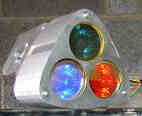

|
 |
The latest acquisition for my lighting rig is a set of 6 NJD Mirage fixtures. These are simple units with 3 x 50W mains GU10 halogen lamps in them, and each lamp has a dichroic glass filter in front of it, either red, green, or blue. Using a standard dimmer pack it is simple to create any desired colour - great for band lighting! Now if I only had a suitable controller...

NJD Mirage lighting fixture
I've already got 44 channels of analogue 0-10V dimmer packs, so DMX control isn't really a viable option even though there are a total of 18 bulbs to control... Being the home of Mad Inventions, it only seems appropriate to build something to control these from scratch. I wanted something standalone since gigs are rarely a safe environment for a laptop - it would either get coverecd in beer or stolen.
Several control strategies were contemplated such as scene based recall, DMX to analogue converters and my old DMX desk, a simple PIC chaser etc... but then I started thinking more about how I would want to use them in a live environment. Sometimes I'd want them to flash like mad, sometimes it'd be nice if they could shimmer around a certain colour tone, and a constant variation between the two would give me full control. I've finally settled on a system best described as 'presettable randomness' which uses 6 controls to set the mood of the lighting.
1 - Density - How many lights are 'active' at any one time?
2 - Activity - This controls slow fades to fast flashes on one control
3 - Colour - The predominant colour of the scene
4 - Colour variance - How far can the system deviate from the requested colour
5 - Saturation - The predominant saturation of the colours in the scene
6 - Saturation variance - How far can the system deviate from the requested saturation
All in all, these should give full control over what these lights are doing. Before lunging for the PIC programmer though, I decided to model the behaviour of the algorithms in Visual Basic to make sure it was doing what was necessary. The code and exe file for this behaviour model can be downloaded from this link:
Download behaviour model code and executable

If you play around with the software, you can quickly see how the scene can be set to anything from bright white flashes to a gentle shimmering colour tone, and anywhere in between - exactly what is needed. I'm sure that there'll be some changes to the algorithms as development continues, but there's only 2 weeks until it needs to be in operation so they may have to wait a while!
The next phase of the design would be to save the settings of these 6 controls into a 'scene' which could then be recalled from non-voltaile memory. The unit will be built into a sloping Hammond case so that it can be used on the desktop for normal gigs, or I can stomp on the footswitches for use in my own gigs (we can't afford a sound/lighting guy yet!)